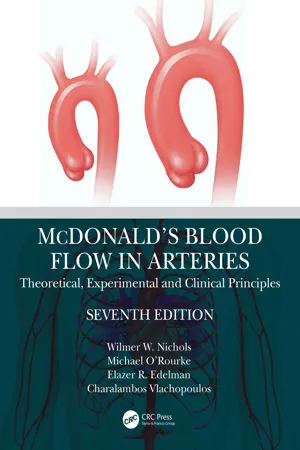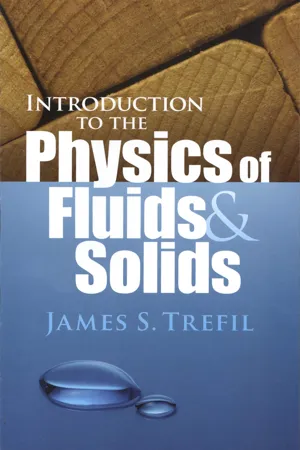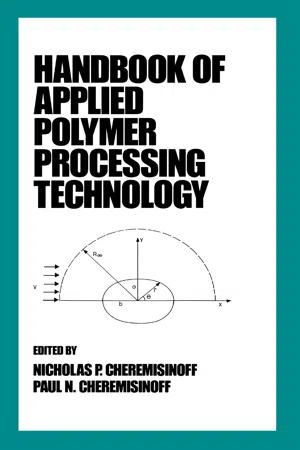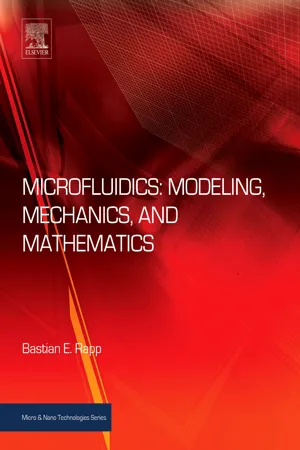Technology & Engineering
Poiseuille Flow
Poiseuille flow refers to the steady, laminar flow of a Newtonian fluid through a cylindrical pipe. It is characterized by a parabolic velocity profile, with the highest velocity at the center of the pipe and decreasing towards the walls. This flow is governed by the Poiseuille's law, which relates the flow rate to the pressure difference and the properties of the fluid and the pipe.
Written by Perlego with AI-assistance
Related key terms
Related key terms
1 of 4
Related key terms
1 of 3
4 Key excerpts on "Poiseuille Flow"
- eBook - ePub
McDonald's Blood Flow in Arteries
Theoretical, Experimental and Clinical Principles
- Wilmer W. Nichols, Michael O'Rourke, Elazer R. Edelman, Charalambos Vlachopoulos, Wilmer W. Nichols, Michael O'Rourke, Elazer R. Edelman, Charalambos Vlachopoulos(Authors)
- 2022(Publication Date)
- CRC Press(Publisher)
If the velocity is altered, the pressure gradient is partly utilized in communicating kinetic energy to the liquid, and the equations do not apply. As the flow in all large arteries and the intrathoracic veins is markedly pulsatile, it is clear that Poiseuille’s equation cannot be applied in these vessels. The velocity profiles and the pressure–flow relationship of flow in these circumstances is considered below. The tube is long compared with the region being studied. Close to the inlet (or entrance) of a tube, flow has not yet become established with the paraboloid velocity profile characteristic of laminar flow. The distance required to establish the steady form of flow is known as the “inlet (or entrance) length”, and here Poiseuille’s equation does not apply. Within the inlet length, the assumption made in the derivation that there are no accelerations along the axis of the tube is not true. It is therefore a special case of the steady flow condition discussed in the previous condition. In viscometers where a flow from a reservoir through a narrow tube is measured, a correction for this effect must be applied (Newman and Searle, 1957). In the circulation, there is never this condition of a stationary reservoir leading to steady laminar flow, so that this correction does not apply. This special problem of the inlet length with pulsating flow in relation to the proximal aorta is discussed in the “Inlet Length” section. The tube is cylindrical in shape. Two stipulations are contained in this assumption: The cross section of the tube is circular, and the walls of the tube are parallel. Most arteries of the systemic circulation are circular in cross section, but many veins and the pulmonary arteries tend to be elliptical rather than circular vessels, and their relatively thin, compliant walls make their cross section subject to the effects of gravity and external pressure from surrounding tissues - eBook - ePub
- James S. Trefil(Author)
- 2012(Publication Date)
- Dover Publications(Publisher)
Problem 8.1 ).B. VISCOUS FLOW THROUGH A PIPE (Poisieulle Flow)An example of viscous flow which occurs often in practical application is the flow of a fluid through a pipe. Let us consider a viscous fluid flowing through a pipe of circular cross section whose walls are perfectly rigid (later, when we consider flow of the blood in arteries, we shall consider the ramifications of allowing the walls to be elastic).Let us further suppose that the system is in a steady state, and that the velocity of the fluid is everywhere in the z-direction (although we allow the possibility that the z-velocity may depend on the coordinate r) and that there is no dependence on the azimuthal angle (this follows from the symmetry of the problem).The z-component of the Navier-Stokes equation then can be writtenUnder the conditions outlined for this problem (steady state flow and the velocity being only in the z-direction and depending only on the radial coordinate), the terms on the left-hand side of the Navier-Stokes equation vanish, and we have for the z-componentwhile the r-component of the equation yieldsEquation (8.B.3) , together with the requirement that the pressure not depend on the angle ϕ, implies that each plane perpendicular to the z-axis is a plane of constant pressure. Since we are dealing with an infinitely long pipe, this implies that the pressure drop in the z -direction must be uniform, orwhere ΔP is the pressure drop in a length Δl. Equation (8.B.2) then becomeswhich can be integrated to givewhere C1 and C2 are constants of integration.As with any differential equation, it is necessary to impose boundary conditions to determine these constants. In this case, we can require that the velocity be everywhere finite, including the point r = 0. This requirement is met by setting C1 - Nicholas P. Cheremisinoff, Paul N. Cheremisinoff(Authors)
- 2020(Publication Date)
- CRC Press(Publisher)
2Flow of Power-Law Fluids Between Coaxial Cylinders
U. V. Shenoy
Indian Institute of Technology, Powai, Bombay, IndiaI. INTRODUCTION
The laminar flow of non-Newtonian fluids in concentric annuli is important in many industrial applications, including drilling of oil wells, certain lubrication and coating problems, as well as the operations of dies and extruders in polymer processing. This chapter focuses on the steady isothermal flow of a power-law fluid in the annular space between two long coaxial cylinders, with one of them in motion and/or an imposed pressure gradient. Depending on whether the pressure gradient and cylinder motion are in the axial or tangential direction, the combined pressure and drag flow may be axial, tangential, or helical. Furthermore, the pressure gradient may assist or oppose the drag on the fluid due to the moving cylinder, and this may lead to a flow reversal in the latter case.The theoretical analyses for these annular flow situations are complex for non-Newtonian fluids. Even for the relatively simple and commonly used power-law rheological model, the literature typically decomposes the problem into different cases depending on whether the shear rate changes sign within the annular region or not. A novel single-case approach is presented below for various annular flow models leading to exact analytical expressions for the volume rate of flow. The solutions typically allow relatively straightforward calculation of the volumetric flow rate and pressure gradient for all values of the power-law index (not merely reciprocal integers) and the annulus aspect ratio.II. ANNULAR FLOW MODELS
The basic annular flow models are discussed first, and then applied to situations of practical importance. As a matter of useful terminology, flows solely due to an imposed pressure gradient are referred to as Poiseuille Flows (or pressure flows), whereas flows solely due to a bounding surface in motion are referred to as Couette flows (or drag flows). Flows with an imposed pressure gradient as well as moving bounding surface(s) are termed generalized Couette flows (or combined pressure and drag flows).- Bastian E. Rapp(Author)
- 2016(Publication Date)
- Elsevier(Publisher)
Fig. 16.4 Velocity and shear force profile in a channel of 10 µm height.Fig. 16.5 Velocity and shear force profile in a channel of 50 µ m height.16.3 Flows in Circular Cross-Sections: Hagen-Poiseuille Flow
16.3.1 Introduction
Obviously, circular cross-sections are a very commonly occurring in technical flow systems. Macroscopic examples include pipes and the tap; microfluidic examples include capillaries and circular tubes. The fluid mechanics of circular tubes or channels is commonly referred to as Hagen-Poiseuille 1 flow . As we will see, the flow profile is parabolic in shape and the shear stress is linear (see Fig. 16.6 ). Calculating the flow in circular cross-sections is not difficult as it exploits the fact that the Navier-Stokes equation in cylindrical coordinates is one-dimensional. There are two approaches deriving the same equation. We will first look at the direct solution of the Navier-Stokes equation in cylindrical coordinates which is the Euler equation.Fig. 16.6 Hagen-Poiseuille Flow in a circular tube. Flow profile (a) and shear stress profile (b).16.3.2 Derivation Using the Euler Equation
Derivation. The first method for approaching the fluid mechanics of circular tube can be directly derived from the Euler equation (see Eq. 14.8 ), which we derived for the circular flow tube. As such, a circular tube or pipe is nothing else than a circular flow tube, which makes this approach very intuitive. Again we only consider the fully-developed and stationary case and neglect gravity. In this case the Euler equation simplifies toτ r+=∂ τ∂ rd pd z(Eq. 16.17)where we assume a pressure drop along the x -axis, which is independent of r ; this allows us to treatas a constant. If we reduce the fluids to incompressible Newtonian fluids we can use Eq. 9.5 to obtain a dependency between the shear forces τ and the velocity v . Please note that, as we will be working with cylindrical coordinates, we use z as the coordinate axis along the channel, in which case Eq. 16.17d pd x
Index pages curate the most relevant extracts from our library of academic textbooks. They’ve been created using an in-house natural language model (NLM), each adding context and meaning to key research topics.
Explore more topic indexes
Explore more topic indexes
1 of 6
Explore more topic indexes
1 of 4



